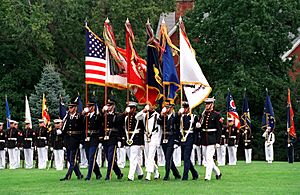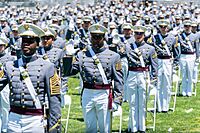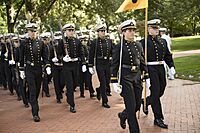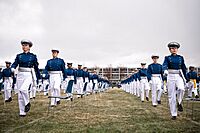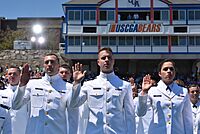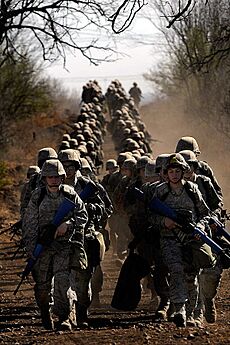Military of the United States facts for kids
The United States Armed Forces is the official name for the military of the United States. It includes several important branches:
- United States Army
- United States Navy
- United States Marine Corps
- United States Air Force
- United States Coast Guard
- United States Space Force
The President of the United States is the top leader, or Commander-in-Chief, of the Armed Forces. Most branches, except the Coast Guard, are part of the Department of Defense. This department is managed by the Secretary of Defense. The Coast Guard is part of the Department of Homeland Security. Interestingly, the Marine Corps is actually part of the Navy!
About 1.4 million people serve actively in the military right now. Another 1,259,000 people are in the reserves, which means they can be called upon if needed. This includes 456,000 people in the Army and Air National Guard. The U.S. military does not currently require people to join (this is called conscription or a draft). Both women and men can serve in almost all military jobs, including many combat roles. Even some jobs that are not officially "combat" can see fighting regularly during wartime.
| United States Armed Forces | |
|---|---|
| Military manpower | |
| Military age | 17–45 years old |
| Availability | Males & Females ages 17–49:
109,305,756 (2005 est.). |
| Citizenship | Regular Army: No Citizenship Requirement For Enlisted Members / All Officers must be US Citizens. National Guard: Citizens Only. |
| Reaching military age annually | Males & Females: 4,180,074 (2005 est.) |
| Total armed forces | 2,685,713 (Ranked 2nd) |
| Active troops | 1,426,713 (Ranked 2nd) |
| Total troops | 2,685,713 (Ranked 7th) |
| Military expenditures | |
| Dollar figure | $441.6 billion (Ranked 1st.) |
| Percent of GDP | 3.7% (FY2006 est.) (Ranked 26th) |
| Dollar Figure (per citizen) | $935.64($1470) (ranked 3rd) |
Contents
Understanding Military Ranks
In the United States Armed Forces, ranks are divided into three main groups: officers, warrant officers, and enlisted personnel. Each group has different responsibilities and ways of joining.
Officers are the leaders of the military. They receive their authority from the President of the United States, and their rank is approved by the Senate.
Warrant officers are specialists. They are experts in specific military technologies and skills. They get their authority from the secretaries of the military departments.
Enlisted personnel make up most of the armed forces. They serve as specialists and leaders at the ground level. As they gain experience, they can become senior non-commissioned officers or senior petty officers.
Military ranks across different services can be compared using their pay grade or NATO rank code.
Officers: Military Leaders
| NATO code | OF-10 | OF-9 | OF-8 | OF-7 | OF-6 | OF-5 | OF-4 | OF-3 | OF-2 | OF-1 | OF(D) | Student officer | ||||||||||||||||||||||||
|---|---|---|---|---|---|---|---|---|---|---|---|---|---|---|---|---|---|---|---|---|---|---|---|---|---|---|---|---|---|---|---|---|---|---|---|---|
| Uniformed services pay grade | Special grade | O-10 | O-9 | O-8 | O-7 | O-6 | O-5 | O-4 | O-3 | O-2 | O-1 | Officer candidate/Cadet | ||||||||||||||||||||||||
 |
 |
 |
 |
 |
 |
 |
 |
 |
 |
 |
Various | |||||||||||||||||||||||||
| General of the Army | General | Lieutenant general | Major general | Brigadier general | Colonel | Lieutenant colonel | Major | Captain | First lieutenant | Second lieutenant | Cadet / Officer candidate |
|
||||||||||||||||||||||||
 |
 |
 |
 |
 |
 |
 |
 |
 |
 |
 (Various insignia) |
||||||||||||||||||||||||||
| General | Lieutenant general | Major general | Brigadier general | Colonel | Lieutenant colonel | Major | Captain | First lieutenant | Second lieutenant | Midshipman / officer candidate
|
||||||||||||||||||||||||||
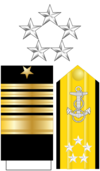 |
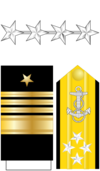 |
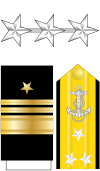 |
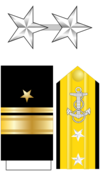 |
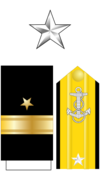 |
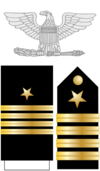 |
 |
 |
 |
 |
 |
 (Various insignia) |
|||||||||||||||||||||||||
| Fleet admiral | Admiral | Vice admiral | Rear admiral | Rear admiral (lower half) |
Captain | Commander | Lieutenant commander | Lieutenant | Lieutenant (junior grade) |
Ensign | Midshipman / officer candidate
|
|||||||||||||||||||||||||
 |
 |
 |
 |
 |
 |
 |
 |
 |
 |
 |
(Various insignia) | |||||||||||||||||||||||||
| General of the Air Force | General | Lieutenant general | Major general | Brigadier general | Colonel | Lieutenant colonel | Major | Captain | First lieutenant | Second lieutenant | Cadet / Officer trainee |
|
||||||||||||||||||||||||
 |
 |
 |
 |
 |
 |
 |
 |
 |
 |
(Various insignia) | ||||||||||||||||||||||||||
| General | Lieutenant general | Major general | Brigadier general | Colonel | Lieutenant colonel | Major | Captain | First lieutenant | Second lieutenant | Cadet / Officer trainee |
|
|||||||||||||||||||||||||
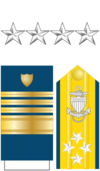 |
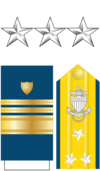 |
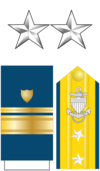 |
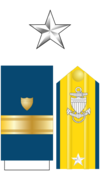 |
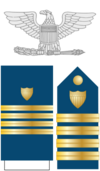 |
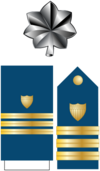 |
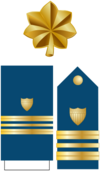 |
 |
 |
 |
Various | ||||||||||||||||||||||||||
| Admiral | Vice admiral | Rear admiral | Rear admiral (lower half) |
Captain | Commander | Lieutenant commander | Lieutenant | Lieutenant (junior grade) |
Ensign | Cadet / officer candidate
|
||||||||||||||||||||||||||
| NATO code | OF-10 | OF-9 | OF-8 | OF-7 | OF-6 | OF-5 | OF-4 | OF-3 | OF-2 | OF-1 | OF(D) | Student officer | ||||||||||||||||||||||||
| Uniformed services pay grade | Special grade | O-10 | O-9 | O-8 | O-7 | O-6 | O-5 | O-4 | O-3 | O-2 | O-1 | Officer candidate/Cadet | ||||||||||||||||||||||||
Officers make up about 18% of the armed forces. They hold important leadership and command roles. Officers are grouped into three categories:
- Junior Officers (O-1 to O-3): These are called Company grade officers in the Army, Marine Corps, Air Force, and Space Force. In the Navy and Coast Guard, they are simply called junior officers.
- Mid-Grade Officers (O-4 to O-6): These are known as Field grade officers in the Army, Marine Corps, Air Force, and Space Force. In the Navy and Coast Guard, they are mid-grade officers.
- Senior Officers (O-7 to O-10): These are General officers in the Army, Marine Corps, Air Force, and Space Force. In the Navy and Coast Guard, they are called flag officers.
Most officers start as second lieutenants or ensigns after getting a bachelor's degree and several years of training. Some can be directly commissioned from civilian life if they have special skills, like being a doctor, lawyer, or cyber expert.
-
The United States Military Academy trains officers for the United States Army.
-
The United States Naval Academy trains officers for the United States Marine Corps and United States Navy.
-
The United States Air Force Academy trains officers for the United States Air Force and United States Space Force.
-
The United States Coast Guard Academy trains officers for the United States Coast Guard.
Officers are trained through special schools like the United States service academies, Reserve Officer Training Corps (ROTC) programs, and Officer Candidate and Officer Training Schools. During a time of war, officers can be promoted to very high ranks, like five-star ranks. Examples include General of the Army and Fleet Admiral.
Warrant Officers: Expert Specialists
| NATO rank | WO-5 | WO-4 | WO-3 | WO-2 | WO-1 | |||||
|---|---|---|---|---|---|---|---|---|---|---|
| Uniformed services pay grade | W-5 | W-4 | W-3 | W-2 | W-1 | |||||
| Chief warrant officer 5 | Chief warrant officer 4 | Chief warrant officer 3 | Chief warrant officer 2 | Warrant officer 1
|
||||||
| Chief warrant officer 5 | Chief warrant officer 4 | Chief warrant officer 3 | Chief warrant officer 2 | Warrant Officer 1
|
||||||
 |
 |
 |
 |
 |
||||||
| Chief warrant officer 5 | Chief warrant officer 4 | Chief warrant officer 3 | Chief warrant officer 2 | Warrant officer 1
|
||||||
| Chief warrant officer 5 | Chief warrant officer 4 | Chief warrant officer 3 | Chief warrant officer 2 | Warrant officer 1
|
||||||
 |
 |
 |
||||||||
| Chief warrant officer 4 | Chief warrant officer 3 | Chief warrant officer 2 | ||||||||
| NATO rank | WO-5 | WO-4 | WO-3 | WO-2 | WO-1 | |||||
| Uniformed services pay grade | W-5 | W-4 | W-3 | W-2 | W-1 | |||||
Warrant officers are highly skilled specialists. They make up only about 8% of the officer group. They are experts in specific military technologies or abilities. The lowest-ranking warrant officers serve under a "warrant," but they receive commissions from the President when they are promoted to chief warrant officer 2. They have authority like commissioned officers but remain focused on their specialized area. The Air Force and Space Force do not have warrant officers.
Most warrant officers were previously non-commissioned officers. However, in Army Aviation, any enlisted person can apply to become a warrant officer. Army Warrant officers attend the Army Warrant Officer Candidate School.
Enlisted Personnel: The Backbone of the Military
| NATO code | OR-9 | OR-8 | OR-7 | OR-6 | OR-5 | OR-4 | OR-3 | OR-2 | OR-1 | |||||||||||||||||||||||||||
|---|---|---|---|---|---|---|---|---|---|---|---|---|---|---|---|---|---|---|---|---|---|---|---|---|---|---|---|---|---|---|---|---|---|---|---|---|
| Uniformed services pay grade | E-9 | E-8 | E-7 | E-6 | E-5 | E-4 | E-3 | E-2 | E-1 | |||||||||||||||||||||||||||
 |
 |
 |
 |
 |
 |
 |
 |
 |
 |
No insignia | ||||||||||||||||||||||||||
| Command sergeant major | Sergeant major | First sergeant | Master sergeant | Sergeant first class | Staff sergeant | Sergeant | Specialist | Corporal | Private first class | Private | Private | |||||||||||||||||||||||||
 |
 |
 |
 |
 |
 |
 |
 |
No insignia | ||||||||||||||||||||||||||||
| Sergeant major | Master gunnery sergeant | First sergeant | Master sergeant | Gunnery sergeant | Staff sergeant | Sergeant | Corporal | Lance corporal | Private first class | Private
|
||||||||||||||||||||||||||
 |
 |
 |
 |
 |
 |
 |
 |
 |
 |
No insignia | ||||||||||||||||||||||||||
| Command master chief petty officer | Master chief petty officer | Command senior chief petty officer | Senior chief petty officer | Chief petty officer | Petty officer first class | Petty officer second class | Petty officer third class | Seaman | Seaman apprentice | Seaman recruit
|
||||||||||||||||||||||||||
 |
 |
 |
 |
 |
 |
 |
No insignia | |||||||||||||||||||||||||||||
| Command chief master sergeant | First sergeant | Chief master sergeant | First sergeant | Senior master sergeant | First sergeant | Master sergeant | Technical sergeant | Staff sergeant | Senior airman | Airman first class | Airman | Airman basic
|
||||||||||||||||||||||||
 |
 |
 |
 |
 |
 |
 |
 |
 |
||||||||||||||||||||||||||||
| Chief master sergeant | Senior master sergeant | Master sergeant | Technical sergeant | Sergeant | Specialist 4 | Specialist 3 | Specialist 2 | Specialist 1
|
||||||||||||||||||||||||||||
 |
 |
 |
 |
 |
 |
 |
 |
 |
 |
|||||||||||||||||||||||||||
| Command master chief petty officer | Master chief petty officer | Senior chief petty officer | Chief petty officer | Petty officer first class | Petty officer second class | Petty officer third class | Seaman | Seaman apprentice | Seaman recruit | |||||||||||||||||||||||||||
| NATO code | OR-9 | OR-8 | OR-7 | OR-6 | OR-5 | OR-4 | OR-3 | OR-2 | OR-1 | |||||||||||||||||||||||||||
| Uniformed services pay grade | E-9 | E-8 | E-7 | E-6 | E-5 | E-4 | E-3 | E-2 | E-1 | |||||||||||||||||||||||||||
Enlisted personnel make up 82% of the armed forces. They serve as specialists and leaders at the tactical level. Enlisted personnel are divided into three categories:
- Junior Enlisted Personnel (E-1 to E-3/4): These are usually new recruits in training or at their first assignment. This includes E-1 to E-3 in the Marine Corps, Navy, and Coast Guard, and E-1 to E-4 in the Army, Air Force, and Space Force. In the Army, specialists (E-4) are junior enlisted, while corporals (E-4) are non-commissioned officers.
- Non-Commissioned Officers (NCOs) (E-4/5 to E-6): These are leaders responsible for tactical operations. They are called non-commissioned officers in the Army, Marine Corps, Air Force, and Space Force. In the Navy and Coast Guard, they are called petty officers. In the Air Force and Space Force, E-5 is the first NCO rank.
- Senior NCOs (E-7 to E-9): These are experienced leaders who advise officers. They are called senior non-commissioned officers in the Army, Marine Corps, Air Force, and Space Force. In the Navy and Coast Guard, they are called chief petty officers.
The rank of senior enlisted advisor is the highest enlisted rank in each service. This person serves as the main advisor to their service's secretary and chief on all matters related to enlisted personnel.
Before joining, all enlisted personnel must complete their service's basic training. After Army Basic Combat Training, recruits go to advanced individual training for their specific job, called a military occupational specialty. Marine Corps recruits complete Recruit Training. Infantry Marines then attend the School of Infantry. Other Marines complete Marine Combat Training before going to technical schools for their Military Occupational Specialty.
In the Navy, after Recruit Training, sailors go to "A" schools for training in their rating. Air Force and Space Force recruits complete combined Basic Military Training before technical training for their Air Force Specialty Codes. Coast Guard recruits complete Recruit Training and then go to "A" schools for their rating.
Images for kids
-
U.S. Army Soldiers with 2nd Battalion, 327th Infantry Regiment, 101st Airborne Division return fire during a firefight with Taliban forces in Barawala Kalay Valley in Kunar province, Afghanistan on 31 March 2011.
-
U.S. Army M1A2 Abrams tanks from the 3rd Armored Cavalry Regiment maneuver in the streets as they conduct a combat patrol in the city of Tall Afar, Iraq, on Feb. 3, 2005.
-
A U.S. Marine Corps MV-22 Osprey tiltrotor aircraft attached to VMX-22 prepares to land on the amphibious assault ship USS America (LHA-6) in the Pacific Ocean.
-
F-22A Raptors in flight.
-
U.S. Air Force B-2A Spirit stealth bombers flying with Royal Air Force F-35B Lightning II stealth fighters.
-
Boeing X-37B spaceplane after deorbiting and landing.
-
USCGC Hamilton and TCG Turgutries in the Black Sea, April 30, 2021.
-
Sergeant Leigh Ann Hester, awarded the Silver Star for direct combat.
See also
 In Spanish: Fuerzas Armadas de los Estados Unidos para niños
In Spanish: Fuerzas Armadas de los Estados Unidos para niños


